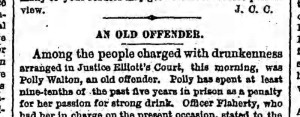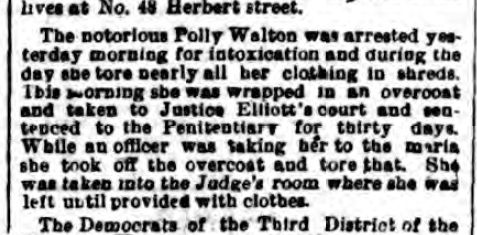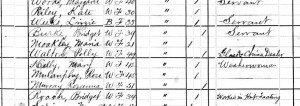THE NOTORIOUS DRUNKEN POLLY WALTON (1880)

In 1879, alcoholism was practically a crime.
And in many cases it was to be punished all the more severely in order that a change might be affected in its indulger.
You either drank or you stopped drinking. There was precious little middle ground and relatively little pity for the alcoholic.
THE CASE OF POLLY WALTON
Polly Walton must have faced some difficult circumstances in her life, as she had at one time had everything – a life, a career, a husband, and two lovely daughters who had married well and were happy in their lives.

After her husband died and her girls were married, her life had become a series of mornings awoken on the floors of jail cells, recovering from far too much alcohol and far too little memory of what had transpired the night before.
Frequently in front of judges, she had gotten very good at promising them everything they wanted to hear. Polly, though, was referred to in the court system as “an old offender.” She was expected to be seen again and again, slowly moving in a downward spiral until one day she was no longer around – a faceless victim of crime which brought her to her last confinement – the city morgue.
“Polly has spent at least nine-tenths of the past five years in prison as a penalty for her passion for strong drink,” so stated the Brooklyn Daily Eagle.
HER DAYS IN COURT
On the morning of 5 February 1879, “the notorious Polly Walton” was arrested for intoxication, and during the day she “tore nearly all her clothing in shreds.” The following morning she was “wrapped in an overcoat & taken to the Penitentiary for 30 days.” While an officer was taking her to “the maria,” though, Polly “took off the overcoat and tore that.”

It is possible that Polly had also had some mental issues presenting, in addition to alcoholism. She was lashing out, becoming violent. But no one saw these or possibly even would have understood them, if they did.
“Polly, what have you to say for yourself?” asked her latest judge.
The disheveled woman, straightening herself up and looking temporarily hopeful, pleaded with the judge for yet another chance.

She was duly liberated.
The Brooklyn courts back then – as now – had more important cases to be dealing with than those of the drunk and disorderly type.
But as it could be guessed at, this was not the end of her brushes with the law.
ONCE MORE & THEN IT’S DONE
A year later on 6 June 1880, Polly was again in court (if she had been out of jail, she’d probably been there several times in the interim), in relation to another drunk and disorderly charge.
This time she was sentenced to the Penitentiary for three months on the complaint of one John Dolan.

The assault brought blood spurting from the wound and trickling down Dolan’s face.
It was a certainty that, in so doing, Polly did not help her case much. So from this incident Polly was given three months additional time.
Ironically – but not surprisingly – she was found in the King’s County Penitentiary just a few days later on 9 June 1880, when the census takers visited the facility to develop their population lists for the 1880 Federal Census.
Listed as a white female of 49 years of age, her profession was put down as a “Glass & China Dealer,” and her place of birth was listed as England. Additionally, she was listed as a widow.
POSTSCRIPT

“Polly was reputed to be worth $40,000 or $50,000 a dozen years ago,” the Brooklyn Daily Eagle noted. “It is said she has two daughter’s married to respectable business men in Philadelphia.”
If anyone knows what ultimately happened to her and where she is buried, they are long gone themselves. It is fully possible that her remains rest on Hart Island, where unknown, homeless, impoverished and otherwise unloved or uncared for “criminal elements” were buried at their lives’ ends.
There is a saying which, in a very melancholic sort of way, should have informed Polly’s future – “The deeper that sadness carves a hole in your heart, the more happiness your heart should be able hold.”
Sadly, while Polly had gotten expert at the carving part, she had had painfully little success at the holding.
———————————————————————————————————————–
 The story you have just read was composed from extensive historical research conducted by The Brownstone Detectives. We perform in-depth investigations on the historic homes of our clients, and produce for them their very own House History Books. Our hardbound books include an illustrated and colorful narrative timeline that will bring the history of any house to life. Contact us today to begin discovering the history of your home.
The story you have just read was composed from extensive historical research conducted by The Brownstone Detectives. We perform in-depth investigations on the historic homes of our clients, and produce for them their very own House History Books. Our hardbound books include an illustrated and colorful narrative timeline that will bring the history of any house to life. Contact us today to begin discovering the history of your home.